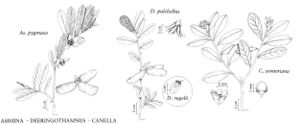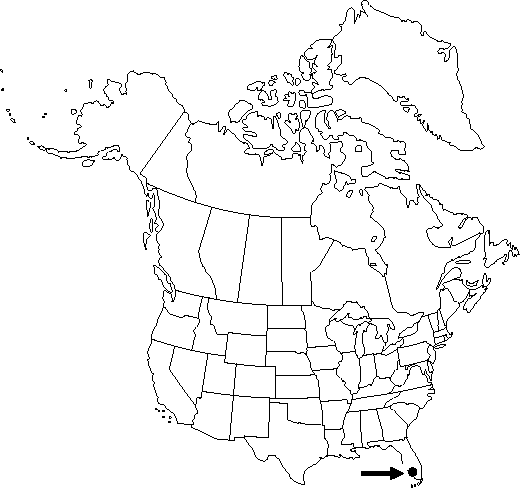Difference between revisions of "Deeringothamnus pulchellus"
Bull. Torrey Bot. Club 51: 390. 1924.
FNA>Volume Importer |
imported>Volume Importer |
||
| (6 intermediate revisions by 2 users not shown) | |||
| Line 16: | Line 16: | ||
}}{{Treatment/ID/Special_status | }}{{Treatment/ID/Special_status | ||
|code=F | |code=F | ||
| − | |label= | + | |label=Illustrated |
}} | }} | ||
|basionyms= | |basionyms= | ||
| Line 22: | Line 22: | ||
|name=Asimina pulchella | |name=Asimina pulchella | ||
|authority=(Small) Rehder & Dayton | |authority=(Small) Rehder & Dayton | ||
| + | |rank=species | ||
}} | }} | ||
|hierarchy=Annonaceae;Deeringothamnus;Deeringothamnus pulchellus | |hierarchy=Annonaceae;Deeringothamnus;Deeringothamnus pulchellus | ||
| Line 38: | Line 39: | ||
|distribution=Fla. | |distribution=Fla. | ||
|discussion=<p>Of conservation concern.</p><!-- | |discussion=<p>Of conservation concern.</p><!-- | ||
| − | --><p>Deeringothamnus pulchellus commonly associates with Asimina reticulata and overlaps with that species in flowering times; no hybrids between them have been observed. When protected from fire, the elongate and branching shoots of D. pulchellus and D. rugelii will persist, but such new growth rarely produces flowers. A conservation measure for such species must involve periodic burning.</p> | + | --><p><i>Deeringothamnus pulchellus</i> commonly associates with <i>Asimina reticulata</i> and overlaps with that species in flowering times; no hybrids between them have been observed. When protected from fire, the elongate and branching shoots of <i>D. pulchellus</i> and <i>D. rugelii</i> will persist, but such new growth rarely produces flowers. A conservation measure for such species must involve periodic burning.</p> |
|tables= | |tables= | ||
|references={{Treatment/Reference | |references={{Treatment/Reference | ||
| Line 53: | Line 54: | ||
-->{{#Taxon: | -->{{#Taxon: | ||
name=Deeringothamnus pulchellus | name=Deeringothamnus pulchellus | ||
| − | |||
|authority=Small | |authority=Small | ||
|rank=species | |rank=species | ||
| Line 67: | Line 67: | ||
|publication title=Bull. Torrey Bot. Club | |publication title=Bull. Torrey Bot. Club | ||
|publication year=1924 | |publication year=1924 | ||
| − | |special status=Conservation concern;Endemic; | + | |special status=Conservation concern;Endemic;Illustrated |
| − | |source xml=https:// | + | |source xml=https://bitbucket.org/aafc-mbb/fna-data-curation/src/2e0870ddd59836b60bcf96646a41e87ea5a5943a/coarse_grained_fna_xml/V3/V3_751.xml |
|genus=Deeringothamnus | |genus=Deeringothamnus | ||
|species=Deeringothamnus pulchellus | |species=Deeringothamnus pulchellus | ||
Latest revision as of 21:51, 5 November 2020
Leaves: petiole 2-4 mm. Leaf blade spreading-ascending, mostly elevated above shoots, oblong to oblong-ovate or spatulate, 4-7 cm, base cuneate to narrowly rounded, margins narrowly revolute, apex obtuse to broadly rounded, often notched. Inflorescences: peduncle slender, 1-3cm. Flowers nodding to ascending, white to pale pink, sweetly fragrant; sepals 2-4, erect, ovate-triangular, ca. 5 mm; petals 6-12(-15), ascending to apically recurved, linear or narrowly oblong, 2-3 cm × ca. 2 mm; pistils (1-)5(-7). Berries 4-7cm. Seeds 1-1.5 cm, slightly flattened laterally.
Phenology: Flowering late winter–spring, all year on disturbance.
Habitat: Sandy peats of slash pine-palmetto flats, savannas
Elevation: 0-50 m
Discussion
Of conservation concern.
Deeringothamnus pulchellus commonly associates with Asimina reticulata and overlaps with that species in flowering times; no hybrids between them have been observed. When protected from fire, the elongate and branching shoots of D. pulchellus and D. rugelii will persist, but such new growth rarely produces flowers. A conservation measure for such species must involve periodic burning.

